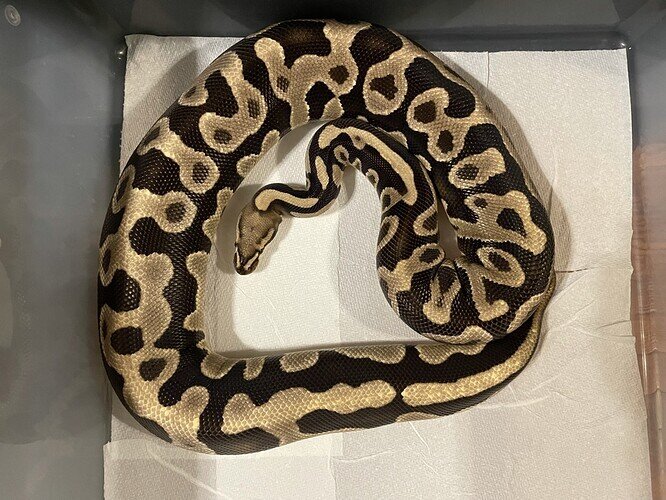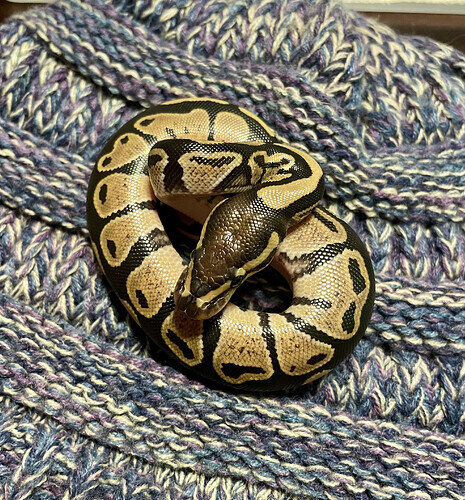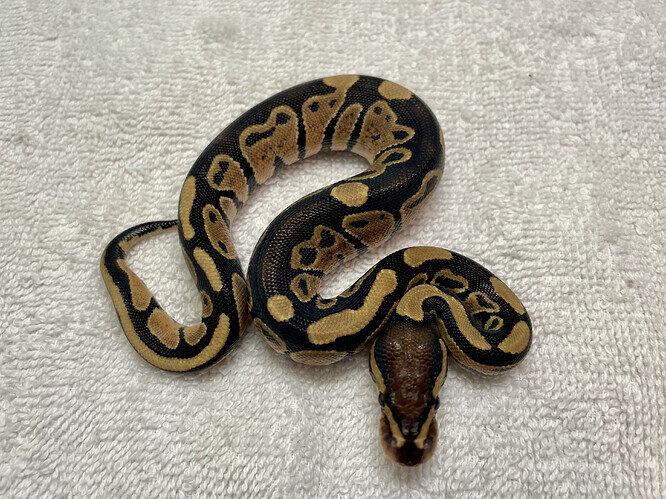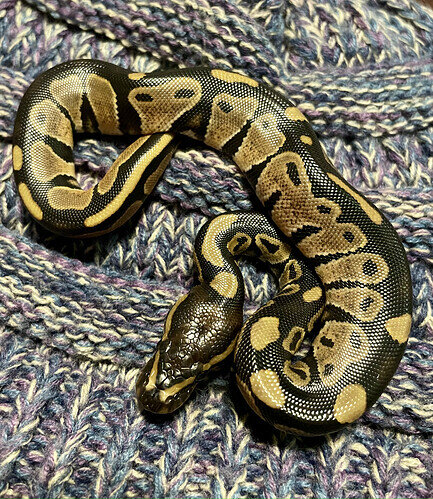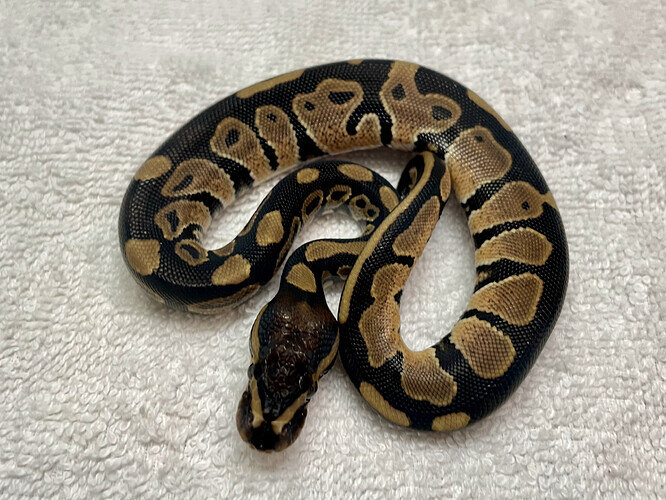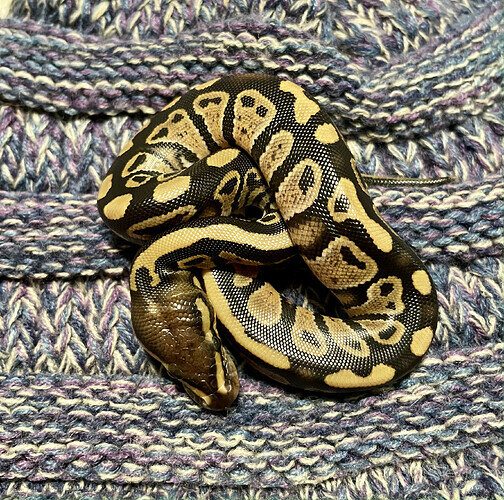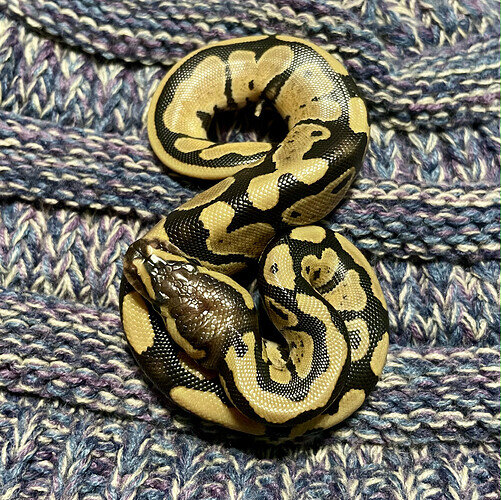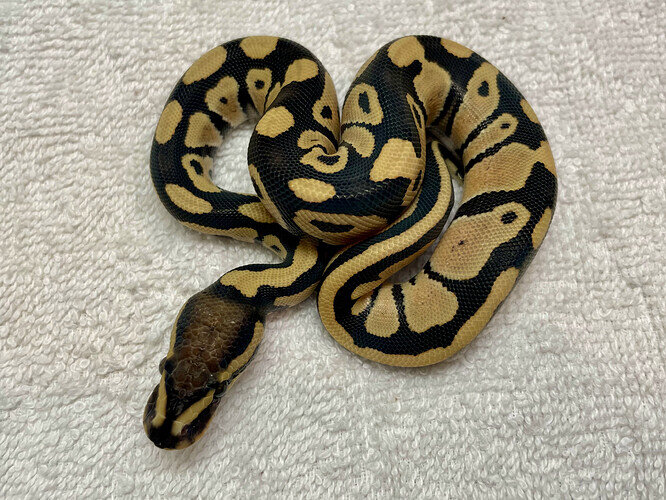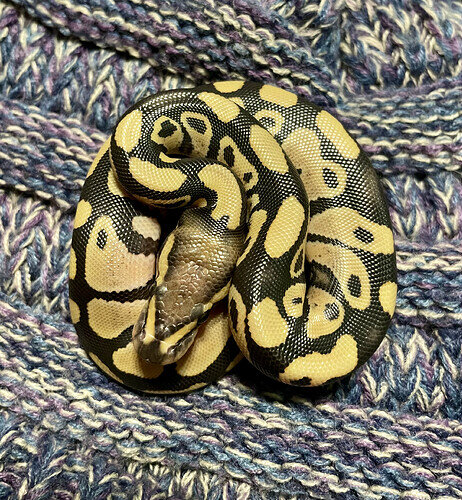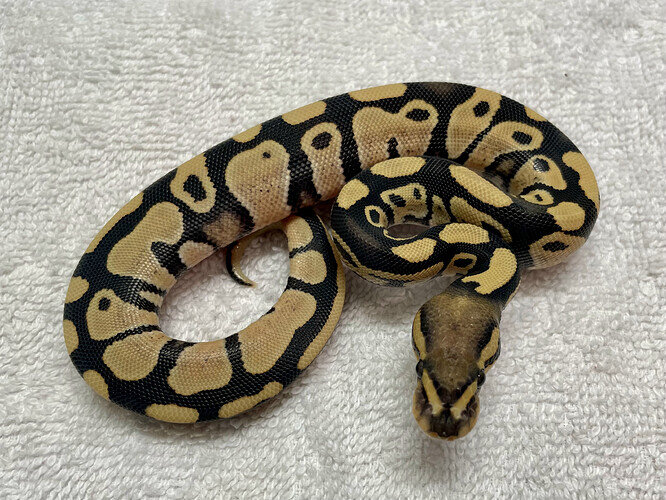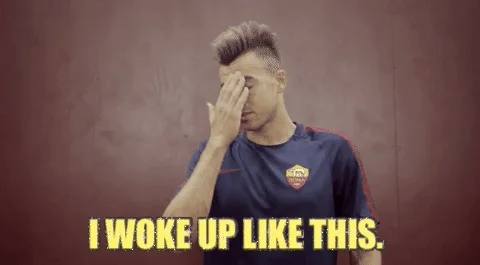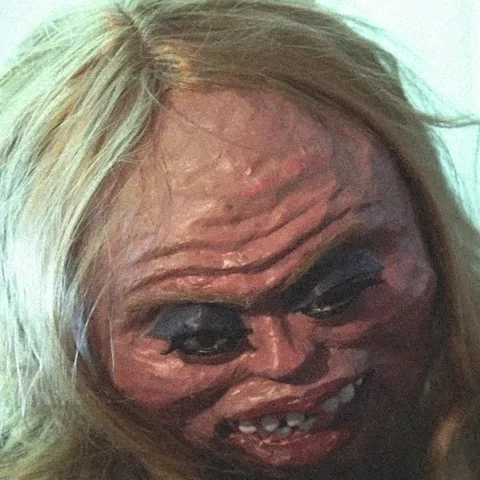A lot of folks here have expressed interest in more explanation as to how breeders go about IDing things, as it often seems like we just know (and sometimes we do, practice makes perfect). But I just hatched a clutch and I figured I would walk y’all through my first initial impressions and what I’ve definitively IDed them as now that they’ve had their first shed.
So: pairing was an enhancer genetic stripe male to a leopard vanilla chocolate het desert ghost. The first thing I do in a pairing like this is verify that the parents are indeed what they were IDed as, because animals are very often incorrectly sold as things they are not. The male enhancer Gstripe is a visual owned by Kori Martin (and is up on her MM page currently, I believe). The mom (picture below) is very obviously leopard and very obviously vanilla (lightened color, head blushing) so the only gene in any kind of question was chocolate, but to me she looked consistent with leo vanilla chocolate (slightly reduced eye stripes and those single holes in reduced leopard pattern). I can use the babies to prove out she is in fact those genes (to some extent).
Now: All out of the egg! There were 7 eggs, one baby (a vanilla DG) unfortunately made it full term and tried to cut out of its egg but died before it could hatch, so 6 babies.
My first impressions out of the egg were two visual DGs (the two rightmost snakes), one that could possibly be DG (at the top right next to the other two DGs) and then three non-visuals. In the egg I actually thought that the bottom middle baby was chocolate DG, but after it came out of the egg it was clear it was not visual.
And: a full clutch pic after shed! Mom proved to be chocolate (right off the bat I see three definite chocolates) and vanilla with the baby that passed in the egg. Surprisingly I didn’t get any leopards, BUT mom is very obviously visually leopard, so it was just bad odds. As you can see though, the babies look very different after shed, which is why it’s so important to not ID babies before their first shed. I also normally base baby IDs on parent expression, but because mom has three genes going on here I’m not entirely sure what her chocolate expression looks like (but I’m guessing keyholes since she has a lot of holes in her pattern).
So now, I’ll post a picture of each baby before and after shed, and what I thought before shed vs. what I’ve IDed them as after shed! Some things I’m keeping in mind here: in my experience, het desert ghost can absolutely make noticeable changes to both pattern and hue. I’m less familiar with het gstripe but if it works like pretty much every other het, I’m assuming it can also alter pattern a bit. So I’m trying to ID these babies while keeping in mind I have multiple factors here that may contribute to what they look like.
Baby #1: Stunning! All of these babies are 100% het DG (if they’re not visual) and 100% het genetic stripe, so I have to keep in mind that can absolutely affect their color and pattern. Before shed, I thought this one was chocolate. After shed, baby #1 is very likely chocolate (reduced and narrowed eye stripes, reduced pattern/black back, mostly keyhole alien heads and the granite flecks in the alien heads). I don’t see vanilla (no clear headstamp or brightness) and no leopard. So I’m currently labeling this one a probable chocolate DH desert ghost gstripe, and often I can narrow down IDs I’m questioning after another couple of sheds.
Baby #2: Normal DH DG gstripe, possible chocolate. Also really cool. Before shed I thought this one was chocolate, but after shed, as much as the keyholes look chocolate in this one, I actually think this is just a normal DH. I don’t see any granite pattern and the back half of the body pattern looks more normal than chocolate, but it’s a toss up because it’s also black backed (something either het could be influencing). This one is possible chocolate but after looking at some normal DHs on MM, I’m thinking just normal.
Baby #3: Chocolate DH DG gstripe. Before shed I actually questioned if this one could be a DG chocolate, but it’s very clear after shed that it’s not - but it is stunning. Granite pattern, keyholes, reduced/narrowed eye stripes - this one is a gorgeous chocolate. It could also be vanilla because of how bright it is, but vanilla is also a pattern-changer and all I see here is chocolate, so I think instead this one is getting its brightness from whatever combination of het DG genes it has.
Baby #4: Vanilla DH DG gstripe! When this one hatched I thought it was just a normal, as I was expecting a very distinct vanilla headstamp like with fire. However, after doing some comparisons on MM, vanilla can actually be a lot more subtle than I thought it was. This one has a blushed head, some subtle wacky pattern, and a more creamy color, so because of this I currently believe it’s vanilla. However, fire and vanilla are both also enhancers like DG (just much more low level) so another shed or two will confirm if this baby is vanilla or not.
Baby #5: This one is my holdback! Before hatching I thought it was a chocolate DG, and after shed it is indeed a chocolate DG. The graininess has been cleared up by DG but the slight blushing on the head and the keyhold-esque patten (also affected a bit by DG) confirm chocolate. A couple friends have also suggested he might ba vanilla chocolate, and while his pattern is consistent with what I’d expect having vanilla in the mix, he lacks the definite bright headstamp I would expect from vanilla, especially seeing the headstamp of the baby that didn’t make it which was DG vanilla. Luckily I’m keeping this boy, so he’ll have many chances down the line to be proven out. He will never go back to his mom, as I don’t want to chance creating super chocolates (or inbreed when I don’t need to) but I have four other girls who will be happy to see him at some point in the future.
And last but not least, baby #6! Very clearly DG (blushed out head, super clean and bright pattern. When this one hatched I also thought it was chocolate DG, and after shed I still think it’s likely chocolate but its expression is definitely different than the male. Her head is way more blushed out and her pattern not quite as reduced. A couple friends have suggested she’s vanilla instead of chocolate which matches with her pattern better, but again, with vanilla I would expect a headstamp enhanced by DG, and she just doesn’t have the headstamp. So I’m labeling her DG possible chocolate, and she already has a home ready for her that doesn’t care one way or the other if she is chocolate.
And then for anyone who’s curious, I do have a picture of the vanilla DG baby (frozen in case a friend with a snake-eater species wants it) that didn’t make it but didn’t post it as I know it really distresses some folks to see dead babies. But I can, if that’s something y’all are interested in.
And of course - nobody is perfect. The next step in my process is always a) more MM comparisons to previously listed animals and b) checking with other breeders, mostly a small group of breeder friends I’ve curated whose ID abilities I trust, but I’m also opening it up here now to y’all.
